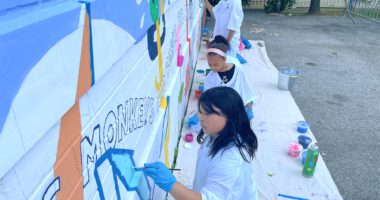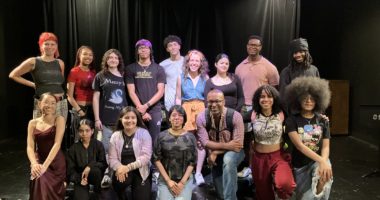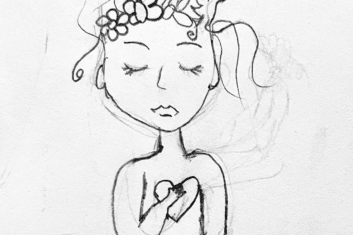Editor’s Note: Even as we’re full speed ahead with our TAP 2018-19 trainees, we’re still reveling in the reflections of our 2017-18 participants. Over the next several weeks, we’ll be sharing several blogs authored by our now-alums. These posts are both delightful throwbacks, as well as hints about what might be ahead for this year’s trainees.
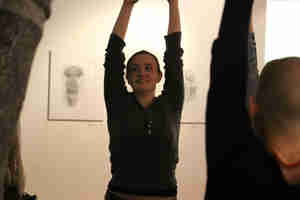

Storytelling is a powerful tool. And not just for artists. The lawyer appeals to the jury’s emotions when defending their clients, historians interpret ancient sagas, mathematicians tell tales in numbers and formulas, reporters bring us events from around the world, and salesmen sell us an idea. Whether you think your job requires storytelling finesse or not, you probably had to interview for that job, which depends upon your ability to convey your own personal narrative in a compelling way.
Our world revolves around the stories we tell. It’s how we connect as human beings; how we learn and inspire each other.
I had the privilege of attending a two-in-one workshop hosted at The Center for Arts Education that focused on the importance of story. Marcus and Malia from Opening Act created space for us to think about our own personal narratives and “connect to ourselves so that we may connect to others.” The idea seemed a little daunting at first. Yet as Luvvie Ajayi said in her TED talk (a prime example of a great storyteller, shared with us by our facilitators): “Get comfortable with being uncomfortable.”
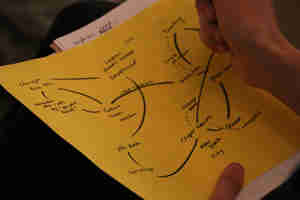

Marcus and Malia expertly guided us on a mini quest to better understand how we view and express our narratives. We first created a “life map” that detailed key milestones in our lives: an entire life of moments, represented on a single page, in any creative fashion we fancied. It was a simple but exciting new way of looking at the big picture of our life adventure and seeing which moments had been most influential. From this activity, we crafted a two minute personal story and practiced telling it to a partner. I was surprised and excited by my partner’s insightful feedback! They had interpreted moments of my story in ways I hadn’t considered before. As Marcus and Malia demonstrated, it’s important that we as teaching artists understand this narrative of self, so that we may connect to the “now” of our work as well as to the stories of the students we wish to reach.


The second workshop was led by Shawn Shafner of The P.O.O.P. Project (The People’s Own Organic Power). Shawn’s approach of “Systems Thinking” invites us to reflect on the many stories that criss-cross and weave themselves together into a complex tapestry.
For example, when I buy my Ben & Jerry’s Boom Chocolatta ice cream at the supermarket, I’m mostly just hung up on whether or not I’ve been neglecting Chunky Monkey for too long. But my encounter with this tub of happiness is only a small part in its own, much larger narrative. Someone had to deliver it. Before that there was a packaging process. Perhaps the packaging was ordered from a different company while another designed the artwork. There were also many ingredients that came from somewhere, that went into machines that also have stories of their own, and so on. So does the story end at the cash register? Nope. My relationship with Ben & Jerry’s is but another phrase in its epic tale. The lid and plastic are tossed in the trash, embarking on their own side quest while Boom Chocolatta goes through my digestive system, and, well…you can imagine the rest.
To quote Shawn, as a consumerist culture, “we focus on what we take in but not what we put out.” We have a troubling mentality of sweeping those uncomfortable realities under the rug. It’s even in the way we talk about our own natural bodily functions as something to be hidden, or shamed. Shawn bravely broke this pattern and shared with us the inspiring story that led him to establish The P.O.O.P. Project: “This is my sh*t. Make fertilizer.”
As a theatre artist who cares about the environment and sustainable sanitation, Shawn has developed an approach for his students to visually set up the systems they are examining. If you can see the system, you can change it. In our workshop, we got to set up the digestive system with each person acting as a different part; I, one half of the stomach making gurgling noises and waving my arms to mimic digestion, or possibly rejection. Each moving part connected together, allowing AnJu, our enthusiastic volunteer, to start her journey as food, from the mouth, down to her swan dive into the toilet. Everyone was in stitches! Once we see the whole, we can then fiddle with the links. We might not want to mess with the digestive system so much, but perhaps in my Ben & Jerry’s system, students could theatrically experiment with various links to learn how they can decrease waste. As Shawn concluded, the story is more complicated than, “I went to the store.”
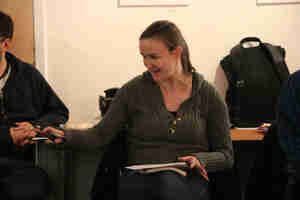

Whether it’s sharing a personal narrative or attempting to grasp the complexity of moments that make up the world we live in, we are breathing a universe of story. As Ursula Le Guin wrote in The Language of the Night: Essays on Fantasy and Science Fiction: “There have been great societies that did not use the wheel, but there have been no societies that did not tell stories.”
Leigh Beaulieu is a theatre artist and TAP alum who works as a teaching artist in New York City.

